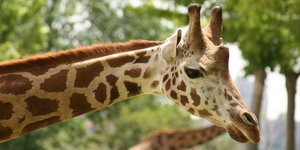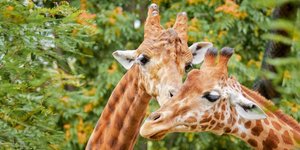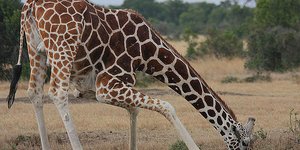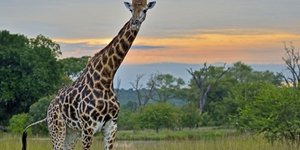Like this article?
Go on, give it a kudu!

Published on April 10 2014 | Updated on November 10 2021
Written by:
Fran
8009 views
There are nine recognized giraffe subspecies found in Africa. These are distinguished on pattern markings, color and geographic distribution.
Conservation for all of Africa's giraffes is extremely important as the species as a whole is facing threats and noticeably decreased numbers.
Find out how to recognize the subspecies and where each is found!
The giraffe, the silent one of Africa’s open plains, grass and woodlands. With its extremely long neck and legs, Africa’s giraffe is the tallest living animal on the planet. Well camouflaged by its coat patterns blending seamlessly with Africa’s arid colors and textures, giraffes have long roamed safely without human threat. But, as Africa’s development escalates and its environmental hazards cause continuous conflict between man and beast, Africa’s giraffe populations have come under severe threat.
Giraffes are among the world’s most recognizable animals, yet they remain vastly under-researched. The fact that, overall, Africa’s giraffe population numbers are decreasing is a huge concern. Key conservation organizations such as the UK-based Giraffe Conservation Foundation describes giraffes as a conservation priority.
So, how many giraffe species and subspecies exist? The answer is, it depends on your reference sourcc. According to the IUCN, the International Union for Conservation of Nature, there are nine giraffe subspecies, all part of the species Giraffa camelopardalis.
These subspecies, in alphabetical order, are:
However, the Giraffe Conservation Foundation, mentioned above, has performed DNA analyses and sampling, and has updated its taxonomy to reflect four distinct species of giraffe and five subspecies. Under this new taxonomy, the species and their respective subspecies are listed below.
You may have wondered what happened to the Rothschild's giraffe. It was found to be genetically identical to the Nubian giraffe. As the nominate species, it took precedence over Rothschild's giraffe.
Next time you visit Africa on safari, know how to identify these species and subspecies, and what each species' specific conservation concerns are. Or, impress your friends at cocktail parties by throwing around the triple giraffa and explaining the taxonomy.
This article was orginally written in before the new taxonomies were discussed and still reflects the nine subspecies recognized by IUCN.
The Nubian giraffe is the first giraffe species ever recorded, hence why its common name in fact refers to the nominate species—the one discovered first. The Nubian giraffe came a long way since its first discovery and it is sad to think that today less than 250 of these beautiful animals remain, mostly in Ethiopia and eastern Sudan. Because of this, the Nubian giraffe is classified as a “red list” animal. The fact that the Nubian giraffe’s geographic location is restricted to Sudan and Ethiopia, countries plagued by severe drought and unrest, makes conservation efforts increasingly difficult. Conservation efforts through captivity are also rare, with only a very limited number of Nubian giraffes in captivity. The Nubian giraffe is distinguished by its chestnut brown and off-white color, with a large square-like coat pattern.
Commonly known as the reticulated, netted or Somali giraffe, this giraffe subspecies is easily recognized by its brown-orange markings which are extremely well defined by a network of white lines (hence the name reticulated or netted). The reticulated giraffe are found in Kenya, Somalia and Ethiopia although the Kenyan populations are the best protected. Reticulated giraffe populations in Ethiopia and Somalia are poorly conserved and estimates are that only small populations exist in these two countries, as opposed to Kenya. The reticulated giraffe is also well represented in captivity, suggesting that captive conservation efforts are more successful for this subspecies. Population numbers in general are looking slightly more positive with research indicating around 5,000 reticulated giraffes still found in the wild. Read more on reticulated giraffes here.
Found in south-western Niger, the endangered West African giraffe was almost extinct in the late 1990s. As few as 50 individuals were left in the 1990s, but since then conservation efforts brought this subspecies back to small population of 300. The African Wildlife Foundation is actively involved with the conservation of this giraffe subspecies and reports that trained guides from local communities are being employed to monitor and protect their own giraffe. Although still endangered, the West African giraffe is now formally protected by the government of Niger. Its distributed now ranges between Nigeria and Senegal. This giraffe with its high conservation importance can be recognized by its overall light cream almost dusty shade, with a tan coat pattern separated by thick cream lines.
The Kordofan giraffe has an interesting research history. This giraffe was only recently distinguished from its close relative, the West African giraffe. Scientists now agree that the Kordofan giraffe is a subspecies in its own right. Although the Kordofan giraffe’s population is fairly stable at an estimated 3,000 giraffes, the Kordofan giraffe is home in African’s most hostile regions: southern Chad, Central African Republic and northern parts of the DRC. Matching its arid savannah environment, the Kordofan giraffe is distinguished by its pale markings. The markings are explicitly irregular, unlike other giraffe species such as the reticulated giraffe. Another distinguishing factor is that the Kordofan giraffe’s markings extend down its upper legs. Read more on the Kordofan giraffe here.
Although formally known as the Angolan giraffe, this giraffe subspecies no longer roams in Angola and is in fact thought to be extinct here. The Angolan giraffe is still found in Botswana, Zambia and parts of Zimbabwe. The true size of the Angolan giraffe population is not entirely confirmed, but estimates are indicating that there are less than 20,000 Angolan giraffes left in southern Africa. When on safari in these regions, the Angolan giraffe can easily be spotted by its overall light camel color. Uneven marks cover the Angolan giraffe’s entire body. The Angolan giraffe’s distribution extends to two prominent locations: the Etosha National Park and the Namib Desert. However, giraffe research is in fact questioning whether the Angolan giraffe found in Etosha and the Namib could in fact be an entirely separate subspecies. Further research is being undertaken to confirm this.
Still in southern Africa, the South African giraffe is a fairly common sight in countries South Africa, southern Botswana and Zimbabwe. This distribution overlaps with the distribution of the Angolan giraffe, although the South African giraffe is the only giraffe found in South Africa. The South African giraffe is brighter in color and star or diamond shaped markings. The South African giraffe’s markings extend down its legs, but do not cover its entire body as in the case of the Angolan giraffe. Scientists are noting the possibility of hybrid populations between these two subspecies in southern Africa. The South African giraffe’s numbers are looking poor at merely 12,000 giraffes, however, there are several conservation efforts focussing on this giraffe species in southern Africa. One such research effort is the collaboration between Mogalakwena Game Reserve and the Giraffe Conservation Foundation—focusing on the status of giraffes across Africa and within South Africa.
A highly endangered giraffe subspecies, Rothschild’s giraffe is found mostly in Kenya. Some refer to Rothschild’s giraffe as the Ugandan giraffe as it once occurred throughout Uganda. The subspecies’ numbers are critically low, with an estimated 1,100 giraffes found in Kenya. Rothschild’s giraffe is, however, by far the most prominent giraffe found in captivity with records showing at least 450 Rothschild’s giraffes in captivity across the world. This means that a significant portion—even up to one third of the Rothschild’s giraffe are home in captive locations. Conservation programs in Kenya and more specifically the Lake Baringa region has been instrumental in re-introducing this giraffe subspecies here—with success. The Rothschild giraffe is easily identified: its markings are irregular fairly dark, even appearing dark brown to black in some body areas. Besides the dark patches, this giraffe is easily identified by its white legs, free of any patterns. Read more on Rothschild's giraffe here.
Found nowhere else than in a small isolated patch in Zambia, Thornicraft’s giraffe or the Rhodesian giraffe is particularly vulnerable due to its very small geographic distribution. Its genetic isolation however did not play a significant role as one would think—research is showing that Thornicroft’s giraffe is not as distinct as once believed. Named after Harry Thornicroft, this population is estimated at around 1,000 giraffes, occurring only in Zambia’s Luangwa Valley. Thornicroft’s giraffe usually has a bold pattern, with a strong reddish brown marking resembling that of a leaf. The pattern with cream background extends down the giraffe’s leg, but does not cover its leg entirely.
Southern, central Kenya and Tanzania is home to the well-known Kilimanjaro or Masai giraffe. This giraffe is widely seen—it is the largest population of giraffe in Africa. The population number is estimated at 37,000 giraffes, but that does not exempt the giraffe from population threats. Poaching, in particular, is on the increase and more intense giraffe conservation is needed. The Masai giraffe is Africa’s darkest giraffe with markings having a distinct dark brown color against a dark red to orange background. The markings are jagged, with shapes resembling veined leaves. The Masai giraffe’s legs are partially covered by patterns and remain a dark color, unlike other giraffe subspecies which are known for their cream-colored legs. Tanzania is particularly fond of their giraffe subspecies and has even named the giraffe as their national animal. Various academic research groups, such as the Wild Nature Institute, have specific programs focussing on conservation research of the Masai giraffe. This program records individual giraffe patterns in great detail—a valuable tool when it comes to monitoring and protection. Read more on the Masai giraffe here.
Unfortunately, since we first published this article in 2015, the giraffe population numbers have continued to decline. In just over a decade, Africa’s giraffe numbers decreased by 60,000. In 2016, the giraffe species in general was uplisted to vulnerable. The Kordofan and Nubian are now listed as critically endangered. Thornicroft is vulnerable.
Giraffe conservation is everything but an easy task—giraffes cover extensive ground and many conservation groups are suggesting that Africa as a continent should collaborate as a unit when it comes to giraffe conservation. After all, Africa’s giraffe literally cover from South Africa to North Africa, across the length and breadth of the continent. Giraffe subspecies still require individual research and monitoring, and many conservationists are of the opinion that there might be even more than only the nine subspecies mentioned here.
Next time you embark on an African safari, take a moment to identify the specific giraffe subspecies and ask your guide about population threats, conservation efforts and the safe-keeping of this precious African species.
Africa’s Giraffe: A Conservation Guide. Giraffe Conservation Foundation. www.giraffeconservation.org
Photo credits: some rights reserved by Amy the Nurse via flickr
Many thanks to Wikimedia for several of the giraffe images.
Has been on: 11 safaris
Seeing beyond the average tourist routes and experiencing local life is my type of travel! Living in South Africa I'm an environmentalist at heart, and I continue to marvel at the beauty of the African continent.
© Your African Safari Ltd, All rights reserved.
Your African Safari is a safari-planning and safari review site. It was created to help support a healthy African wildlife population. All reviews are vetted before being approved and only ethical tours are published

All about the Masai giraffe
Published on March 07 2024
By: yourafricansafari.com

The mysterious Kordofan giraffe
Published on January 13 2022
By: yourafricansafari.com

Where to find reticulated giraffes in Africa?
Published on August 30 2021 | Updated on September 08 2021
By: yourafricansafari.com

The Rotchild's giraffe: Time to act
Published on July 14 2013
By: Mike Sage